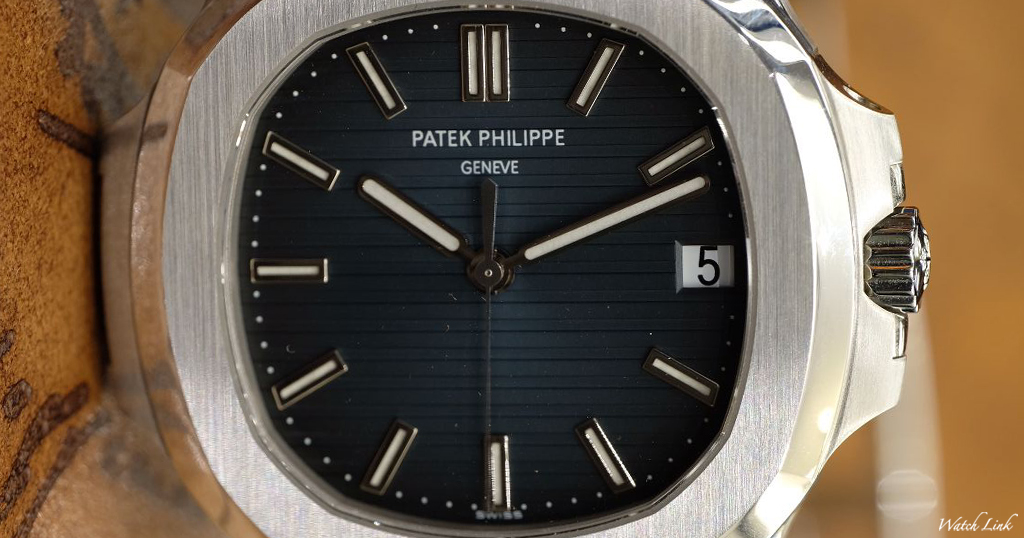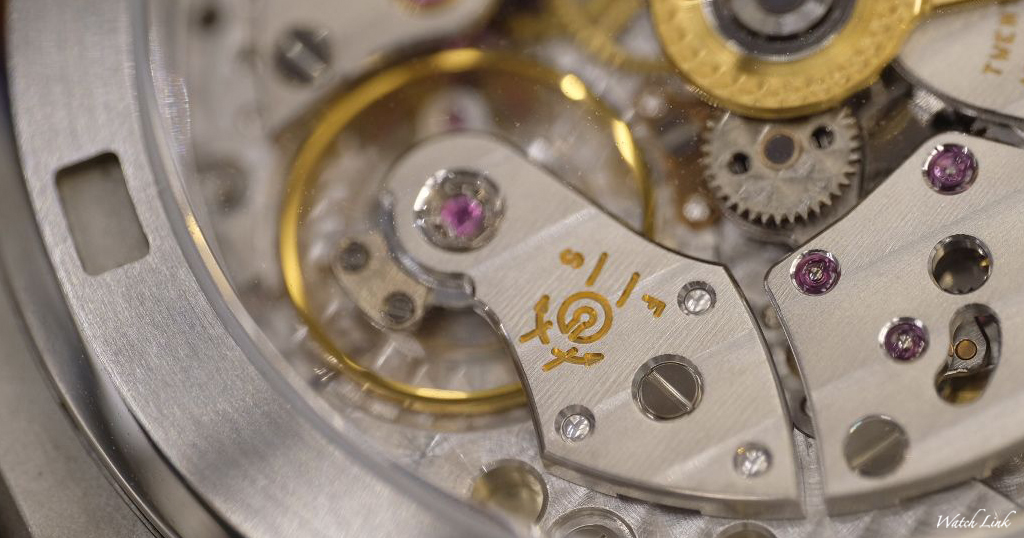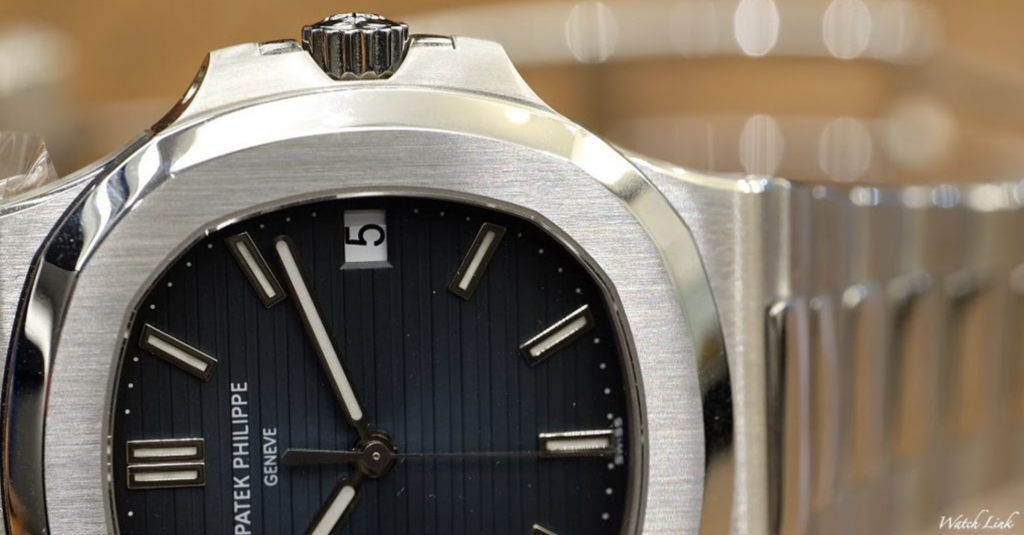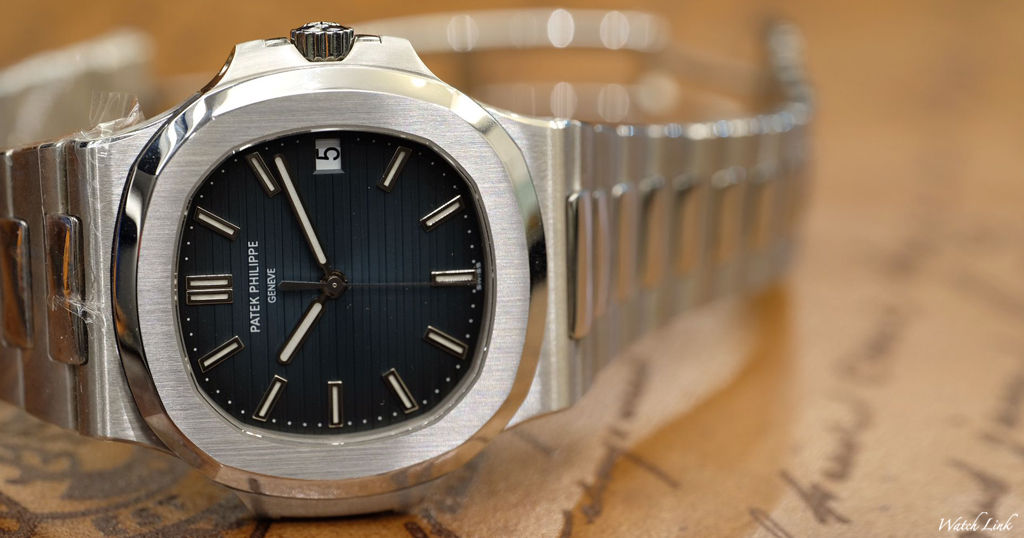Considering that 5711s with the Cal. 315 were in production for less than a year, the estimated ratio of first series examples to the other series throughout the15 years lifespan is between 1 in 15 and 1 in 30.
5711 is the most basic Nautilus model from the second generation of the Nautilus family. Yet, it is the most desirable due to its clean and sleek aesthetic.
Most watch collectors following Patek Philippe Nautilus will be no stranger to the Cal 324 SC in the highly desirable 5711. However, if you came across a 5711 with Cal. 315, don’t worry, there is a high chance that it’s one of the few early examples produced in 2006.
Just in case if you are not aware, when 5711 debuted in 2006, Patek Philippe did not have the existing Cal. 324 SC ready in production for the new Nautilus. During the transition period, Cal. 315 were used instead.
Before the discontinuation of Geneva seal Pateks in 2009, there are two different types of Geneva seal movement for the 5711:
– Cal. 324 SC (Geneva seal) 2007 – 2009
– Cal. 315 (Geneva Seal) 2006 – ~2007
In this article, we will dive into the history, detail and collectibility of the Nautilus 5711 Cal. 315.
For an overview for the entire Nautilus collection, check out our previous article:
The Beginning of a New Era
The Patek Philippe Nautilus Ref. 5711/1A is introduced in 2006, Nautilus’ 30th Anniversary, to pay homage to the original Nautilus 3700 and replace the limited production Nautilus 3711.
To commemorate this significant milestone, Patek Philippe redesigned the entire Nautilus collection and launched no less than 4 new watches. The moon phase power reserve 3712 was replaced by 5712 with slight differences while the collection extends with the new mid-size version 5800. The first-ever Nautilus Chronograph is also launched, with the introduction of the highly desirable 5980.

However, the main highlight within the new 2006 Nautilus collection is the introduction of the 5711. The emblematic 5711 is a proper comeback of the earliest steel jumbo. Simplicity is the best form of beauty and with this introduction of a time-and-date only complication, the 5711 is the perfect modern interpretation of the 3700.
Other than steel models, rose gold models and the introduction of optional leather straps was something new from the house of Patek.
Why is the 5711 so highly desirable? A sleek but bold stainless steel sports watch, with a blue dial, and a clean aesthetic like the 3700, it best sums up what the Nautilus is for collectors. The original design grammar of Gerald Genta is instantly recognisable and you can see how faithful the 5711 is, compared to the icon born in 1976. But when we dive into the details, the 5711 reveals a rather strong evolution.
Patek measures the case at 40 mm, from 10:00 to 4:00 and as 43 mm, as measured across the dial, from 9:00 to 3:00. Unlike the original 3700 with a straight hinge, the 5711 is convex at the hinge and crown, matching the bezel. The new Nautilus case is also composed of three main components due to the new sapphire case back. The solid steel case back is updated with a sapphire crystal allowing the movement to be viewed.
The 5711 covers all of the Nautilus foundation: stainless steel octagonal case, two lateral hinges, an integrated bracelet, a mix of brushed and polished surfaces, a simple display on a grooved blue dial.
Here is an exhaustive list of the evolutions from 3700 to 5711:
Case- the 5711 has a 3-part case: central container, bezel, sapphire case back. The 3700 had a monobloc case, with a central container/case back module and bezel. Water resistance is 120m for both.
Hinges- The hinges are curved on the 5711. While the hinges are straight on the 3700
Size- 5711 measures 43mm (ear to ear) while the 3700 was 42mm. Proportions are still the same.
Thickness– The 5711 is slightly thicker, at 8.3mm versus 7.6mm for the 3700. This is due to the sapphire case back, the new movement and the new display. Despite the increase in size, the 5711 is still the slimmest model to date.
Crown- Screw-down crown on the 5711 is bigger than the 3700.
Bracelet- The 5711 has central links that are rather flat, while the 3700 had rounded central links. This gives a more contemporary touch to the 5711. The 3700 clasp is a double folding blade and the 5711 is a triple folding buckle on the 5711. Both 5711 and 3700 has a flip-lock piece on top of the buckle.
Dial- Although both have a blue dial, with horizontal grooves, the 5711 has a more electric blue tone and a stronger gradient finish. The grooves on the 5711 are also wider and deeper. Typography on dials are also different, with the 3700 maintaining a vintage look, the 5711 has a more modern font. Indexes on the 5711 carry a bolder look, filled with superluminova. 3700 is tritium.
Display- This is probably the most noticeable difference between 5711 and 3700. While the 3700 was a 2-hand time-and-date, the 5711 adds a central second hand.
Although there are a lot of similarities between 5711 and 3700, on the wrist, both watches are quite different. The 5711 on the wrist is naturally more qualitative, being slightly heavier and bigger. The evolution is subtle but the combination of a larger case with an increment of 1mm, more pronounced blue on the dial, with larger grooves and larger indexes and hands, gives more robustness to the 5711.
5711 Variations
Just within the 5711 collections alone, there are a couple of variants available. Most of the differences are between the materials used. Steel, gold, platinum, integrated bracelet or leather bracelets, these differences are the easiest to spot.
Although the platinum 5711s are the rarest know models to the public, not many collectors are aware of one specific 5711 that could probably be the most limited produced 5711 ever.
The first-gen. 5711 Cal. 315.
A VERY RARE EXAMPLE
On the surface, the first-gen 5711/1A looks just like any other 5711s. Probably most of you are aware of the difference between the geneva seal and the Patek seal, which was introduced in 2009. But do you know that the movement powering the first batch of 5711 is actually Cal. 315 SC instead of the more commonly known Cal. 324 SC?
The short-lived Cal. 315 SC

The Nautilus 5711 was launched with Patek Philippe’s in-house full-rotor automatic Calibre 315 SC but this was quickly replaced that same year with the new Cal. 324 SC. This new calibre oscillates at 28,800 A/h rather than the 21,600 A/h of the 315 SC and incorporates many other changes besides.
Despite the “upgrade” from 315 to 324, the rarity and history behind the CAL. 315 mark its place in the highly collectable category.
The Cal. 315 was an innovative movement on its introduction around 1984, replacing its predecessor and ill-conceived Cal. 335 and 310. Cal. 315 shares the same architecture with Cal. 335, but with many upgraded technicalities. The most critical improvement was the reduction in frequency to 21,600 A/h and a more durable uni-directional automatic winding motor. The Cal. 315 is also used for 100 Advanced Research Cal. 315 movements presented in 2005 with a silicon escape wheel and ceramic bearings.
One controversy about Cal. 315 is the number of jewels used. Patek Philippe initially said it had 29 jewels, but later revised this to 30. However, the company went back to saying it had 29 jewels.
The 5711/1A was originally launched in 2006 with Patek Philippe’s in-house full-rotor automatic Calibre 315 SC but in a very short period of time (around 6 months) this was quickly replaced with the new Cal. 324 SC.
There are a couple of conspiracies behind the reason why but it could be due to the Cal. 324 SC not being ready for production and Patek does not want to delay the new Nautilus release for the 30th anniversary. So they brought out the 5711 with their original Cal. 315SC movement, replacing it with the Cal. 324 SC when it became available.
Another reason could be because Patek Philippe would want to use all of their 315 calibres available before transiting to 324. Highly unlikely for the Stern family to do that, but then, who knows.
Due to the fact that the Cal. 315SC was replaced within 6 months of production, examples like the present watch, with the cal. 315, are much rarer than all the subsequent examples.
Calibre 315 was an innovative movement on its introduction around 1984, replacing the ill-conceived Cal. 335 and 310. Although sharing its basic architecture with the 335, Cal. 315 was improved in almost every way. The most critical improvement was a reduction in frequency to 21,600 A/h and more durable uni-directional automatic winding gears, addressing a critical issue in the 28,800 A/h Cal. 310. Later, 100 “Advanced Research” Cal. 315 movements were presented in 2005 with a silicon escape wheel and ceramic bearings. Although most watch models use the newer Cal. 324, a few continue with the now-venerable 315.

Spec Sheet (315 vs 324):
The Cal. 315 SC has a self-winding mechanism, with a central gold rotor, Geneva Seal certification, 30 jewels and Gyromax balance beating at 3Hz.
- Mechanical self-winding movement with date
- Total diameter: 27 mm
- Thickness: 3.22 mm
- Power reserve: 48h max
- Balance-wheel: Gyromax
- Number of parts: 213
- Vibrations per hour: 21’600
- Jewels: 30
- Geneva Seal Hallmark
The Cal. 324 SC movement runs at a frequency of 4 Hertz (28,800 semi-oscillations per hour).
This assures high rate accuracy and an extremely constant amplitude of the balance.
- Mechanical self-winding movement with date
- Total diameter: 27 mm
- Thickness: 3.30 mm
- Balance-wheel: Gyromax
- Number of parts: 213
- Power reserve: 45h max
- Jewels: 29
- Vibrations per hour: 28’800
- Geneva Seal Hallmark or Patek Seal Hallmark after 2009
So, exactly how rare is a Patek Philippe Nautilus 5711 with the Cal. 315?

Think about it.
5711s with geneva seal were in production for around 3 years before Patek introduced their own hallmark on their in-house movement. This means there will be LESSER Geneva seals produced than Patek seals.
Add on the fact that Cal. 315 is almost immediately replaced with Cal. 324. The production period is estimated to be from 6 months to a year. Even if they produce two 5711 a day, there are less than 1000 examples sold to the public.
If you just want a 5711, the Cal. 324 is probably sufficient to satisfy your craving. However, if you want something unique and rare; a conversation starter among your collector friends; a piece of transitional history of Patek Philippe; an investment piece on your wrist, the limited production Cal. 315 will be an ideal addition to your collection.
Given the mythical status of this model, and the 5711’s recent discontinuation, it is safe to say that the first series Nautilus is an extremely rare gem, destined to obtain the highly collectable territory. The new owner of this scarce work of horology will experience an exceptional occasion. This is one, for the most discerning of collectors to enjoy.
Based on historical prices in auction houses and transacted sales in the grey market, the 5711s with Cal. 315 is estimated to have an annual growth of ~14% in value.

